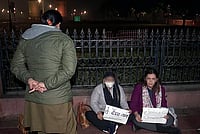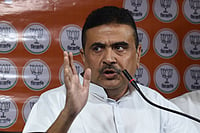The Calm and Early Signs of Conflict
By Anuradha Bhasin Jamwal
Bright flowery printed salwar-kameez on her slightly plump frame, black Bata school shoes, and plaited, oiled, jet-black hair that ended in blood-red, thick nylon ribbons, dilated pupils, slurring lips slightly frothy, twigs in hand – this image of Suraiya is one of the most defining ones from my childhood in Jammu. Children were intimidated by her presence, and some pelted stones from behind as she trudged from her three-storey red-brick house in Dalpatian locality towards the junction between Karbala Grounds and Wazarat Road. She would chase the kids, shout incomprehensible gibberish and return to collecting twigs, stopping people, or letting them pass only if they gave her a stick. Suraiya kept chasing children, shouting and collecting twigs till her grey-haired mother came to take her home. Mostly, Suraiya would return with one of her shoes lost, a ribbon undone and sometimes with a bleeding wound.
In the 1970s and ’80s, Suraiya, known in the locality as Suraiya Paagal (crazy), was a living icon of Jammu in 1947. As a six-year-old, she had witnessed her entire family, except for her mother, being burnt alive by Hindus and Sikhs during the post-Partition riots. After that, she had lost her mental balance. While my generation was growing up, Suraiya’s story was not unique; there were many such around us, whose faces spoke of the bloodied streets of Jammu. It was easy to stumble on these narratives in a neighbourhood that had once had a huge Muslim population, one that had thinned drastically in October–November 1947.
Though there were many of them, the stories also seemed distant because at the time I was growing up, communal amity was at its best. My childhood was yet to be shattered by the rise of the Hindu right and the insurgency of the 1990s. Of course, Jammu did suffer from the fallout of the Punjab insurgency in the mid-1980s. My first experience of being caught in the web of ‘us and them’ was when I heard stories whispered of how Sikhs had distributed sweets after Indira Gandhi’s assassination, and how Hindus had taunted Sikhs after Operation Blue Star. The shocking memory of a Hindu friend asking a Sikh friend, ‘Why did you kill Indira Gandhi?’ is something I have not been able to shrug off my mind.
I was born in 1968, when the gory Partition, and Jammu and Kashmir’s accession and division were two decades old. The 1965 war was over and the 1971 war was yet to come. My memories of the 1971 war are rather hazy, though I recall blackouts, a trench dug in our lawn, mention of bombings, hovering aircrafts, and a midnight visit by an uncle who was in the army, clad in his fatigues. Till Punjab militancy erupted and spilled over to Jammu, life had been simple and harmonious, without the consciousness of who we were and how we were divided into the binaries of collective identities. The year 1984 when Indira Gandhi was assassinated marked the Hindu–Sikh disaffection, which also began taking on The Calm and Early Signs of Conflict 103 the tones of Hindu–Muslim polarization, when the Kashmiri youth took up guns in 1989.
In the 1980s, communal violence of the scale witnessed in 1947 seemed like tales from folklore. Perhaps this was also due to my own innocence and blissful ignorance of the complex narrative of Jammu, making it seem something unrealistic that could not be replicated. Before 1984, there had been, of course, glimpses of issues pertaining to the location, history and politics of Jammu visà-vis the Kashmir dispute. It was in 1984 that my curiosity over the past and religious identities was invoked when I began reading and talking to the people in my life who had lived through those times. It was surprising to discover that Jammu and Kashmir had a very different history from the rest of the subcontinent, that the Quit Kashmir movement against the Dogra rulers coincided with the Indian freedom movement, and that Jammu and Kashmir had acceded to India while a part of the state was usurped by Pakistan.
In 1947, around the time of Partition, the upper-caste Hindus owed their loyalty first to the Hindu maharaja and then to India. Most Muslims in the Jammu region were supporters of the Muslim Conference, which favoured a complete merger with Pakistan. The Sheikh Abdullah–led National Conference had never been effective in the districts of Jammu, Kathua, Udhampur and Reasi. The Muslim population, which was culturally a part of Punjab and shared its customs, dress, language and even food habits, had come under the influence of the Pakistan movement years before Partition.
The state of Jammu and Kashmir enjoyed autonomy after 1947 under Article 370 of the Constitution of India. It first had its own prime minister and Sadr-i-Riyasat (president of the state), not the Indian president’s man called governor. All residents had a state subject certificate, which was like a sacred document. There was often discussion of Article 370, talks of removing it or protecting it. In the 1980s, when Farooq Abdullah revived the autonomy slogan to reclaim his voters, historians began writing articles about the Amritsar Treaty, according to which Kashmir had been bought by the Dogra rulers from the British for 75 lakh rupees. These disclosures inspired the feeling of ‘differentness’ of the state. In Jammu, which enjoyed great cultural affinity with Punjab and even Himachal Pradesh, the integration with India seemed pretty much final, despite these signs of uniqueness.
(Excerpted from the collection A Desolation Called Peace edited by Ather Zia and Javaid Iqbal Bhat with permission from HarperCollins India)


























